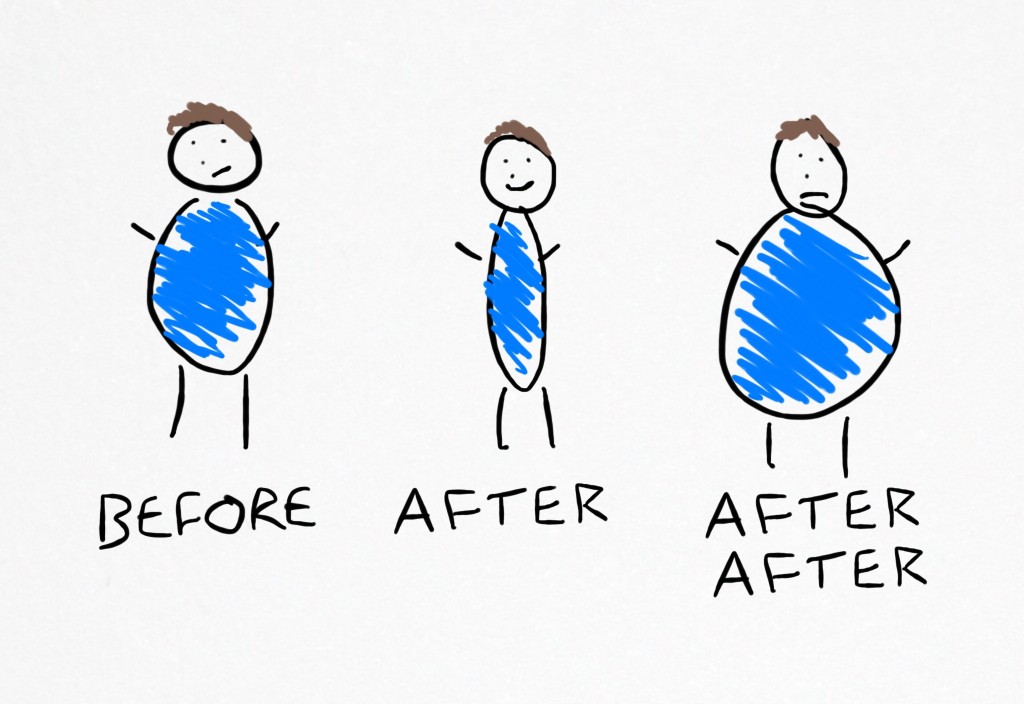The weight-loss game is a popular one to play. It has been said that in 2002 alone, 231 million Europeans attempted some form of diet[i]. Would that number be any less today? Probably not.
The problem is …even if successful weight loss is achieved, studies show that 80%-90% of people return to their previous weight[ii].
Clearly, we’re doing it wrong.
Here are 5 mistakes I commonly see people making in their weight loss efforts.
…And you probably don’t think you’re making them.
1. Starvation
You won’t admit you’re starving, but you probably are. Most of the weight loss clients I’ve worked with aren’t eating enough food.
I frequently meet females trying to get by on less than 1400kcal per day. For the majority of females who actually have some weight to lose, 1400kcal barely covers their basal metabolic rate. Add in all that exercise, and in many cases, the body is seriously under-fuelled (starving).
This leads to “adaptive thermogenesis” in which the body “creates the ideal situation for weight regain”[iii]. So when you finally ‘break’ your diet, guess what happens?
Oh, and if you’re starving, it’s pretty much inevitable that you will break your diet. If you can’t stop binging on the weekends, it’s maybe because you’re starving through the week. Repeated restrict-binge cycles are not helpful.
2. Extremism
Whenever someone asks me about some crazy weight-loss diet or exercise plan, my first question is usually, “what happens when you stop?”
You know what happens. Regain.
Maybe you don’t think your programme is extreme. But if it’s drastic change from your regular habits you’ll find it hard to sustain. In general, the more restrictive a diet is, the less sustainable it is. The more extreme an exercise programme is, the less sustainable it is. On-off-on-off health kicks aren’t helping.
For what it’s worth, spending the entire day sat on your backside is pretty extreme too. …Even if it is sustainable.
What we need is consistency. And that means moderation. So you can enjoy it. And sustain it. For the long haul.
3. Addressing only the symptom
If you are carrying too much body fat, there is a reason for it. Something has caused that. The excess body fat itself is merely a symptom of something gone awry.
The trap we fall into is focussing only on the symptom: the fat. When we do that, and we ask, “how can I lose the fat?”, we sometimes get some wacky answers. We get the aforementioned starvation, fad diets and extreme exercise ‘programmes’. We get miracle fat loss ‘treatments’ and potentially dangerous diet pills. But without addressing the cause of our excess body fat, even if we do lose weight, the fat will likely return.
What’s the cause? It is possible that there is a medical explanation, but usually it lies in our daily habits. Our lifestyle. Probably you’re not eating an appropriate amount of food – even if you think you are. Probably you’re lacking in some important nutrients. Probably you’re not as active as you think. Probably you’re under too much stress. And I’d bet you’re not sleeping enough – or well enough.
Fix your habits – do the fundamentals, consistently, over time and everything else should fall into place …if you’re patient.
4. Relying on cardio
Cardio exercise alone is not a smart way to lose weight.
A study involving obese women showed that an exercise programme comprising of five, 45-minute sessions at 78% of their maximum heart-rate, for 12 weeks (more or less what we see most folks doing in the gym), had “no discernable effects on body composition”[iv]. All that work and they didn’t lose weight!
Even if you do lose weight with cardio, it’s likely that you’ll be losing muscle; not fat. Losing muscle is a great way to reduce your overall energy expenditure meaning it’s a lot easier to regain that weight in the future.
In another study which compared diet-only, diet-plus-aerobic-exercise, and diet-plus-aerobics-plus-strength-training, the addition of an aerobic training programme (30-50 minutes, three times a week for 12 weeks) didn’t result in any more fat loss than just diet alone! The group that included strength training, however, lost 44% more fat than the diet-only group[v].
As well as eating an appropriate amount, it’d be wise to lift some weights!
5. Overeating
People are horrible at estimating their food intake[vi],[vii],[viii]. There’s a good chance you’re eating more food than you think you are. 18-54% of people are – and that number is as high as 70% in some groups[ix].
Who are these diet ‘under reporters’?
Those with “higher social desirability” and “greater eating restraint” are most likely to under-report their food intake. Having a history of dieting and being overweight are also associated[x]. Women are more likely than men[xi]. Active people are more likely than inactive people[xii].
If you’re reading this blog, I’d wager you fall into at least one of those categories!
And guess which foods we under-report?
“Underreporting of food intake does not result from a systematical underestimation of portion sizes for all food items, but seems to concern specific food items which are generally considered ‘bad for health’.”[xiii]
Even when we’re trying to be conscientious, we somehow manage to forget about those few extra high-calorie foods that might just be sabotaging our weight loss efforts.
Solutions
- Nourish your body. Hunger isn’t designed to make you fat. Pay attention to internal cues or track your food intake for a few weeks.
- Practice moderation: your diet and exercise programme must be enjoyable to be sustainable. That includes eating ‘bad’ foods.
- Fix your habits and lifestyle: do the fundamentals, consistently, over time.
- Practice strength training: lift some weights!
- Eat mindfully: eat slowly and listen to your body. Or track your food intake (everything!) for a few weeks.
- What a guide? Get the exact nutrition guidelines I share with my clients.
Always Keep Reaching!
Mike
References
[i] Hill, AJ. Does dieting make you fat? Br J Nutr. 2004 Aug;92 Suppl 1:S15-8.
[ii] McGuire MT, Wing RR, Klem ML, Hill JO. Behavioral strategies of individuals who have maintained long-term weight losses. Obes Res. 1999 Jul;7(4):334-41.
[iii] Rosenbaum & Leibel. Adaptive thermogenesis in humans. Int J Obes (Lond). 2010 October; 34(0 1): S47–S55.
[iv] Utter et al. 1998. Influence of diet and/or exercise on body composition and cardiorespiratory fitness in obese women. Int J Sport Nutr. 1998 Sep;8(3):213-22.
[v] Kramer, Volek et al. 1999. Influence of exercise training on physiological and performance changes with weight loss in men. Med. Sci. Sports Exerc., Vol. 31, No. 9, pp. 1320-1329
[vi] Lichtman et al. Discrepancy between self-reported and actual caloric intake and exercise in obese subjects. N Engl J Med. 1992 Dec 31;327(27):1893-8.
[vii] Cook, et al. The problem of accuracy in dietary surveys. Analysis of the over 65 UK National Diet and Nutrition Survey. J Epidemiol Community Health. 2000 August; 54(8): 611–616.
[viii] Samaras et al. Dietary underreporting is prevalent in middle-aged British women and is not related to adiposity (percentage body fat).Int J Obes Relat Metab Disord. 1999 Aug;23(8):881-8.
[ix] Macdiarmid J, Blundell. Assessing dietary intake: Who, what and why of under-reporting. J.Nutr Res Rev. 1998 Dec;11(2):231-53.
[x] Maurer et al. The psychosocial and behavioral characteristics related to energy misreporting. Nutr Rev. 2006 Feb;64(2 Pt 1):53-66.
[xi] Macdiarmid J, Blundell. Assessing dietary intake: Who, what and why of under-reporting. J.Nutr Res Rev. 1998 Dec;11(2):231-53.
[xii] Garriguet, D. Under-reporting of energy intake in the Canadian Community Health Survey.Health Rep. 2008 Dec;19(4):37-45.
[xiii] Lafay et al. Does energy intake underreporting involve all kinds of food or only specific food items? Results from the Fleurbaix Laventie Ville Santé (FLVS) study. Int J Obes Relat Metab Disord. 2000 Nov;24(11):1500-6.





